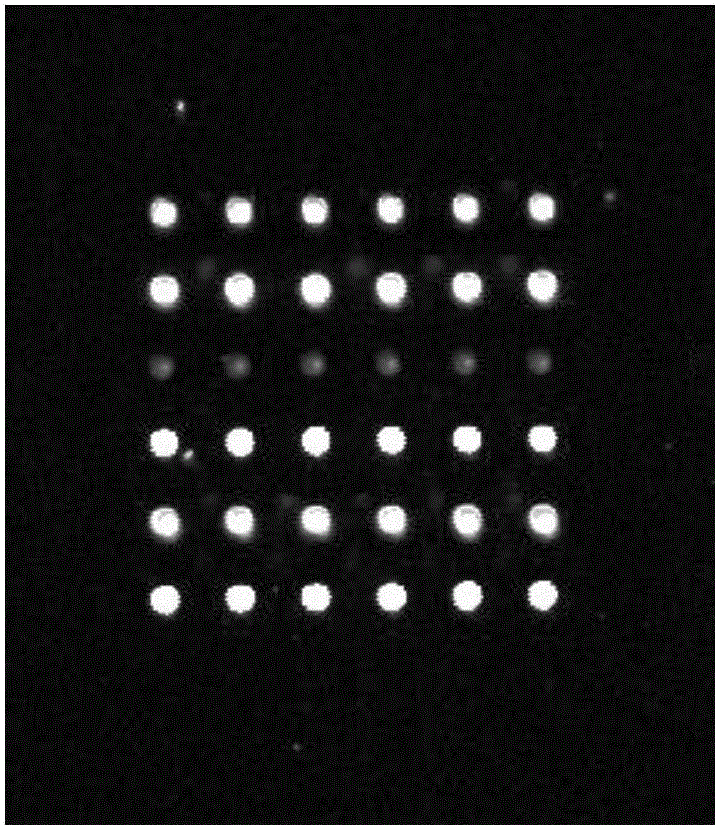Gene chip for detecting environmental pollutant DEHP (di-2-ethylhexyl phthalate), and preparation method and application thereof
A gene chip and environmental detection technology, which is applied in the field of environmental pollutant detection, can solve the problems of undisclosed gene chips, etc., and achieve the effects of sensitive detection results, rapid identification, and strong specificity
- Summary
- Abstract
- Description
- Claims
- Application Information
AI Technical Summary
Problems solved by technology
Method used
Image
Examples
specific Embodiment 1
[0040]A kind of gene chip that is used to detect environmental pollutant DEHP, comprises the probe that spots on glass slide, and described probe comprises probe 1, probe 2 and probe 3, wherein
[0041] Probe 1 has the nucleotide sequence shown in SEQIDNO.1, and the fragment length is 125bp. The nucleotide sequence of the forward primer used in amplification probe 1 is: 5'-GGGACATATCCAATGGTGAC-3', and the reverse primer used in amplification probe 1 The nucleotide sequence of the primer is: 5'-GCCCTCTTGCGTTCTAGTTT-3';
[0042] Probe 2 has the nucleotide sequence shown in SEQIDNO.2, the fragment length is 200bp, the forward primer nucleotide sequence used for amplification probe 2 is: 5'-TGCCCGTGCTTACTATTGAC-3', the reverse primer used for amplification probe 2 The nucleotide sequence of the primer is: 5'-CCTTTCTTCCTCGTTATCCT-3';
[0043] Probe 3 has the nucleotide sequence shown in SEQIDNO.3, the fragment length is 179bp, the forward primer nucleotide sequence used for amplif...
specific Embodiment 2
[0044] 1. Discovery of DEHP biomarkers
[0045] Molecular markers for candidates were obtained through the previous analysis of differentially expressed genes and temporal expression changes of proteins in different tissues of Clam philippines.
[0046] 2. Gene chip preparation
[0047] a. Extraction of total RNA: Take 1.0 mL of clam body cavity fluid, centrifuge at 800 g for 5 min, collect blood cells, add 1.0 mL of RNAiso-plus reagent (purchased from Takara Company), oscillate and mix, and place at room temperature for 5 min, then add 0.2 mL of chloroform, Shake and mix well, let stand at room temperature for 10min, 4°C, 12000rpm, centrifuge for 15min, pipette the supernatant into a PE tube, add the same volume of isopropanol as the supernatant, mix well, let stand at room temperature for 5min, 4°C, 12000rpm , centrifuge for 10 min, remove the supernatant, add 1 mL of ethanol with a mass percentage concentration of 75% to the pellet, centrifuge at 4°C, 12000 rpm for 5 min, ...
specific Embodiment 3
[0059] 1. Preparation of low-concentration hybridization template
[0060] a, sample acquisition: laboratory conditions simulate DEHP stress Philippine clam, DEHP stress experiment is that Philippine clam is exposed to the seawater of the DEHP that final concentration is 0.4mg / L; In seawater; after 36 hours of stress, take 1.0 mL of clam coelom fluid, centrifuge at 800 g for 5 min, and collect blood cells;
[0061] b. Total RNA extraction: The obtained blood cells were immediately extracted and purified with the AxyPrep Total RNA Mini Kit;
[0062] c. Labeling of RNA samples and acquisition of cDNA: the control group was labeled with Cy3 fluorescence, and the treatment group was labeled with Cy5 fluorescence:
[0063] Total RNA 20ug make up 8μL
[0064] Oligo (dT) 18 primer 1 μL
[0065] External standard (no homology gene fragment) 1 μL
[0066] Denature at 65oC for 5 minutes, and place at room temperature for 10 minutes;
[0067] Then add 5×1ststrandbuffer4μL
[0068] ...
PUM
 Login to View More
Login to View More Abstract
Description
Claims
Application Information
 Login to View More
Login to View More - R&D
- Intellectual Property
- Life Sciences
- Materials
- Tech Scout
- Unparalleled Data Quality
- Higher Quality Content
- 60% Fewer Hallucinations
Browse by: Latest US Patents, China's latest patents, Technical Efficacy Thesaurus, Application Domain, Technology Topic, Popular Technical Reports.
© 2025 PatSnap. All rights reserved.Legal|Privacy policy|Modern Slavery Act Transparency Statement|Sitemap|About US| Contact US: help@patsnap.com



